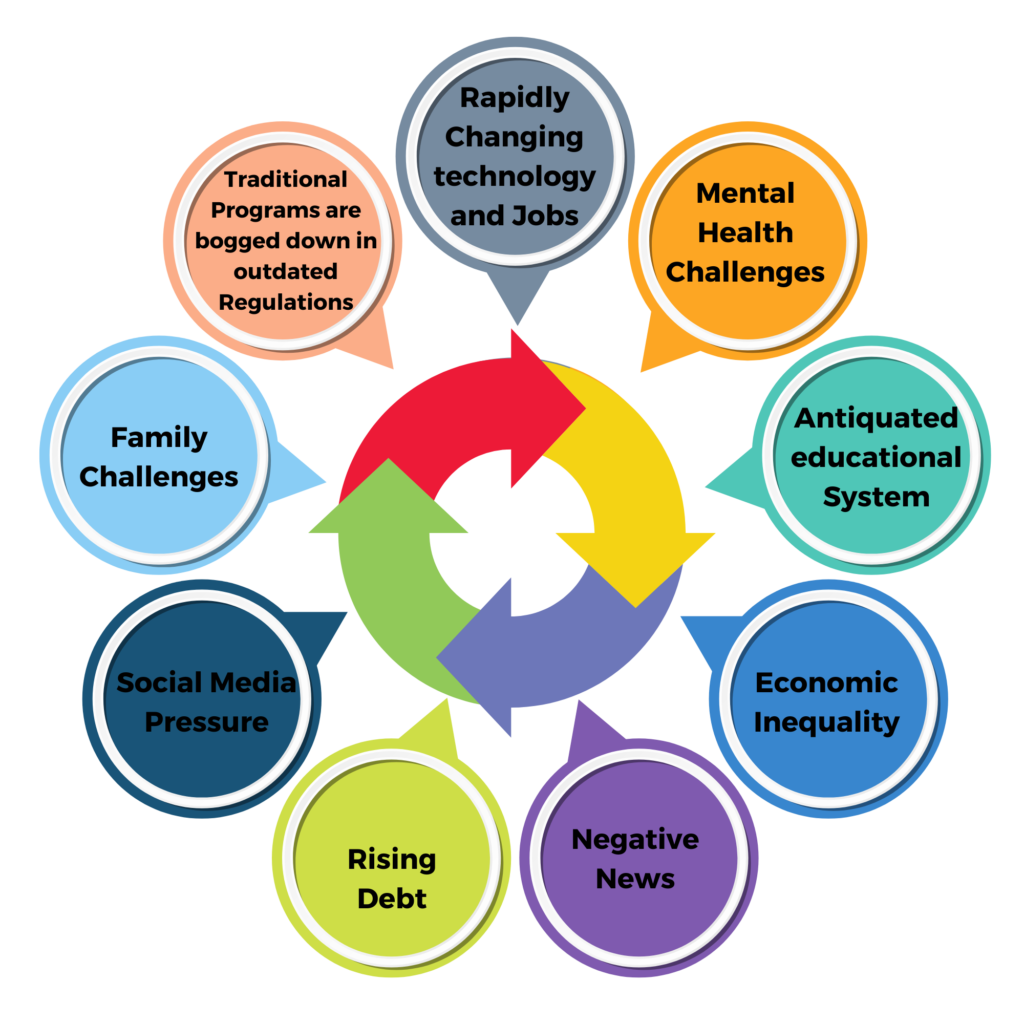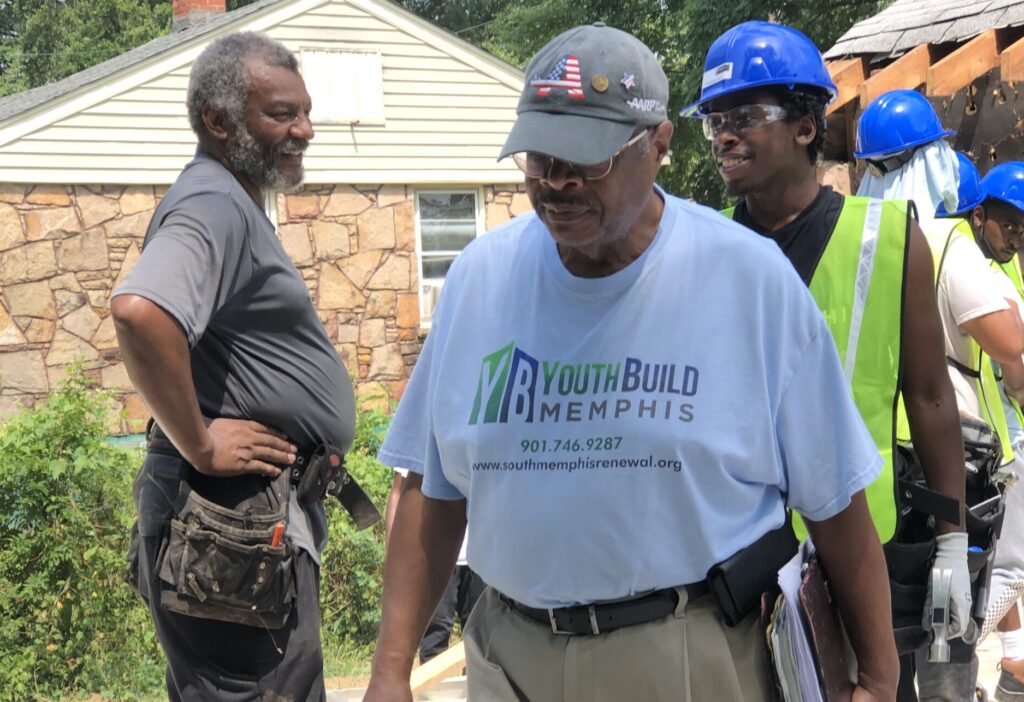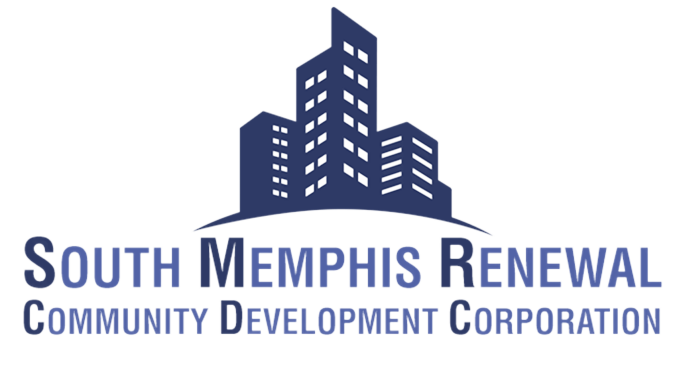South Memphis Renewal CDC Workforce Development Division
Empower Youth Ready Workforce Innovation (EYRWI)
The Problem
America’s Youth are facing challenges unlike previous generations have never faced!
Opportunity Youth Are Looking to Reconnect to School or Work, Build Strong Families, and Make a Difference, but Significant Challenges Stand in the Way
The good news is that most youth out of school and out of work, whom we will call “opportunity youth” because they represent enormous untapped potential for our society, start out life with big dreams that include graduating from college. notwithstanding challenging life circumstances, including living in poverty, they remain optimistic about their futures and believe they will achieve their goals in life. they accept responsibility for their decisions, but also yearn for support along what they hope will be a road to opportunity. our society often treats them as problems to be addressed, but their voices show that they are potential to be fulfilled and can become key leaders in our society if given a chance.

Collectively, we're failing to help them meet these challenges. We're failing to prepare youth for life in the 21st century.
There are millions of youth ages 16 to 24 who are out of school and out of Work. We have labeled them “Opportunity Youth” they cost the nation Billions of dollars every year and over their lifetimes in lost productivity and increased social services. they also represent an opportunity for the nation to tap the talents of millions of potential leaders and productive workers at a time when America’s skills gap is significant.
Opportunity Youth Are Confident or Hopeful about Achieving their Goals, and accept Responsibility for Their Futures, but need additional supports despite coming from challenging circumstances, the majority of opportunity youth are very confident or hopeful that they can achieve their goals and they accept responsibility for their own futures. having clear goals and a dependable support system are strongly associated with feeling confident about the future.

Opportunity Youth Point the Way to Reconnecting according to opportunity youth, opportunities to simultaneously earn money and attend school to build. While many surveyed express a desire to go back to school, in reality, significant barriers prevent them from achieving their goal. Opportunity road January 2012, 5 credentials are the most attractive avenues to reconnecting peer groups and mentors are also important to helping them get back on track.
Training that allows students to earn money and to attend school at the same time ranks highest on a list of programs designed to help young people go back to school, find work, or help them with everyday problems, with 78 percent expressing interest in this type of support. Job training and apprenticeships receive the second highest marks at 70 percent, including 76 percent of men and 67 percent of women.
Opportunity youth want to work with peers and mentors. When asked who they would like to see in a new community center dedicated to helping them succeed, successful peers (79 percent), college mentors (69 percent), parents or family (67 percent) and business mentors or advocates from my community (65 percent) rank highest, suggesting that many sectors in local communities can help them reconnect.
Paths Forward
SMRCDC recognizes the value of all youth to our communities, economy, and nation. these young people want to gain educational credentials and job training, while recognizing their need to simultaneously earn a living to support themselves and, in many cases, their families. We must do this through integrated and supportive responses that do not treat education and a job as mutually exclusive goals nor fail to recognize the individual issues and lack of support that calls the young people’s attention away from the classroom. there are 30,000 Opportunity youth in Memphis and more when the five count MSA is included — about 1 in 6 of all youth 16 to 24 years old. 6 opportunity road January 2012
Integrated Community Solutions that make a difference in communities with dropout rates exceeding 50 percent, it will take interventions at scale to put young people back on track to re-engage them in school, work, and civic life. It will require constructive engagement of our youth service systems and our public and private resources to build these pathways to opportunities and support young people over time as they navigate from the streets to the programs and campuses, to the labor market, and to adult success. Youth opportunity grants should target low-income communities, foster community collaboration among multiple sectors, and adopt systemic approaches to re-enrolling dropouts into local charter or “back on track” schools or programs focused on dropout reengagement and preparation for the labor market.
Reward and Scale Up Effective Programs so Providers Can Open their Doors to Youth Stranded on Waiting Lists all existing comprehensive programs designed for opportunity youth that have been shown to be effective and have waiting lists should be expanded to welcome all the young people seeking a chance to get back on track. When programs are successful at reconnecting youth, they do not necessarily receive additional funding. the money the government saves by successfully reconnecting youth is often saved by a different program or agency than the one that served the youth. For example, if a program like the U.S. Department of labor’s YouthBuild program is able to successfully train and graduate a youth who was perhaps on food stamps or statistically more likely to commit a crime, the savings gained as a result of the youth no longer needing food stamps or not entering the juvenile justice system benefit these other agencies; they are not reinvested in YouthBuild. We need to turn that equation around by rewarding successful programs with more funding, which could be done at a fraction of the cost of the social services opportunity youth will otherwise need, so we can further reduce the need for government spending over these youth’s lifetimes and reduce the enormous costs to the taxpayer. Invest in programs for success initiatives ensure that savings are reinvested in scaling up successful programs.
Investing in the spread of effective programming is necessary but not sufficient. National investment is also needed to support the invention and piloting of new pathways to success for opportunity youth. Such investment can build on the creativity of local community-based organizations across the country that are on the front lines of serving these young people. The investing in EYRWI-type programs, YouthBuild and the City/County/State’s Workforce Programs are potential models for such an investment.
Disconnected Measurement Systems lead to Disconnected Youth as our call for integrated community solutions made clear, reconnecting opportunity youth requires a number of institutions, systems and organizations working together. To do so with precision, community leaders need rigorous data to hold decision-makers collectively accountable for results. Too often, instead of having one effective data and accountability system, communities have multiple fragmented data systems, each of which lacks the breadth and capacity to be used to drive overarching accountability for opportunity youth. These parallel data systems often make redundant technological expenditures, collect overlapping sets of information, and are built in ways that inhibit the flow and transfer of data among them. As a result, despite new resources devoted to data systems, most community leaders still do not have the information they need to be effective. In 2011, opportunity youth cost the taxpayer $93 Billion. Over their lifetimes, this cohort of opportunity youth Will cost taxpayers $1.6 trillion.
Communities often have multiple, fragmented efforts to serve opportunity youth, each governed by a separate federal policy which creates red tape and frustrates efforts by community leaders to align disjointed services into a coherent strategy to reconnect young people to productive adulthood. Most obvious are the differences in eligibility requirements for various federal programs, and different data management systems to measure demographics and impact.
Employers play an essential role in helping create career pathways for disconnected young adults. While some employers are actively providing career pathways for these young adults, incentives are needed to get more employers to the table as a partner in this critical role. The federal government took a small step in that direction by authorizing the disconnected youth opportunity tax credit (dyotc) in the American recovery and reinvestment act of 2010. The dyotc provided a tax credit to employers who hire an opportunity youth, as defined by the law. This approach needs to become permanent and, rather than just reward employers for hiring opportunity youth, it should include incentives for employers to provide a range of valuable experiences such as training and internship opportunities provided directly by an employer or in partnership with a community-based program. Another tool for employers is the youth employment toolkit being developed by the White house council for community solutions. the toolkit is a resource that helps companies build an engagement program for opportunity youth or expand on an existing program by focusing on activities that can provide opportunity youth with work-related skills, exposure to workplace experiences, and employment. It should be reauthorized in 2023 and beyond.
Bring Opportunity Youth to the table as policies are developed that affect their lives. Our survey showed that opportunity youth are more likely to respond to reconnection strategies that provide strong, integrated supports and treat them as part of the solution rather than the problem. It is important to recognize their responsibility and their voice in reconnecting to school or career training. The programs that engage them should likewise offer a place at the table for opportunity youth and successfully reconnected youth to incorporate their feedback and evaluation in refining programs that serve youth. The federal government could help by establishing a presidential youth council to empower disadvantaged youth across the country, and to ensure that scarce federal resources for youth programs are directed toward where they can bring the most benefit.
Support similar efforts at the state and local levels as was made clear by the 2003 White house task force on disadvantaged youth, the federal government runs hundreds of programs to serve children and youth ages 0-24, spread across at least 12 departments and agencies. Many of these efforts are essential and effective; however, they are not part of an integrated, strategic plan to help opportunity youth achieve successful adulthood and they too often work in silos that create barriers that frustrate outcomes. By creating a federal child and youth cabinet and publishing a cohesive national youth policy strategy, government could provide leadership that transcends silos, provides a clear vision for success for all efforts supporting children and youth, and helps communities implement holistic solutions that work.




Course Offering based on Regional Workforce Demand
Young people (under the age of 30) make up over half of today’s global population, with some projections being as high as 75% by 2030. A 2021 report estimated the youth labor force (16-24-year-olds working or looking for work) to be over 22 million in the U.S. That said, having a youth-friendly workplace would seem to be a no-brainer. Yet, youth employment rates are considerably low compared to historical standards, and the potential negative effects of this trend could also be a major motivator for employers to become more youth friendly.
The requirement for more education and training is one cause for lower employment rates. For young people who are neither in school nor working – often referred to as “Opportunity Youth” – the personal burden and the resulting strain on the local economy can both be significant. Unemployed or underemployed youth led to lower tax revenue, higher government spending, and reduced economic growth. On an individual level, longer-term effects on socioeconomic mobility are also more severe for young people who do not have stable jobs by their early twenties, including joblessness or permanently lower earnings, health risks, lower education levels, and a greater likelihood for criminal justice involvement.
SMRCDC is concentrating on matching the jobs that employers need or demand to the training that employers deem is necessary to create employees that are ready to hire in the Memphis Market. Empower Youth Ready Workforce Innovation (EYRWI) is an opportunity for our partners to carry out creative solutions that address local workforce issues. It encourages employers, community leaders, and others to lead efforts for developing regional workforce talent pools. Employers can promote credit and non-credit education and training opportunities in high-demand jobs. The EYRWI can be designed in innovative ways to help Youth achieve their training and education goals.
Program Design Narrative
When it comes to businesses, there’s one challenge that rises to the top; there is a significant shortage and skills gap that hinders companies’ effort to expand, innovate and thrive. That’s where EYRWI design is critical. WE designed our program to ensure we are training to the needs of the local workforce, dismissing traditional standards of workforce development, while providing the skills needed by the empower, we are engaged with. EYRWI will demand employees who have the disciples to learn new skill, work in a team environment, remove barriers that hinder workforce success- transportation- interpersonal skills- proper training and intensive wraparound skills that we will teach and enhance.
Best of all employees will receives the support that will build them into work ready employees when they leave our program and ensure they meet industry standards in field that include everything from construction, Medical Devices, Healthcare, IT, Manufacturing Technology. Our designs include the use of Certified Apprenticeship Program is another way that EYRWI will ensure that our regional and employees will meet their goals of employment Building on YouthBuild principles and expanding our reach of youth who need workforce skills.
Intensive mental toughness assessment, WEX – training in selected industry, Educations Training in areas lacking or gaining GEDs’ when required and Community engagement, which we deemed is necessary for them to understand where they live and how to be better citizens.



